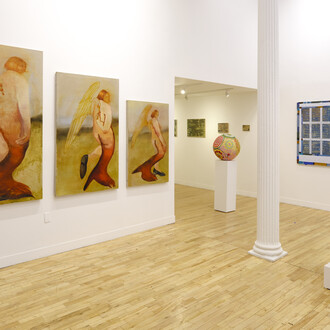Daumier (1808-1879): Visions of Paris will be the first major exhibition of the prolific artist and social commentator, Honoré Daumier, to be held in Britain for over fifty years. Admired by the avantgarde circles of 19th century France and described by Baudelaire as one of the most important men ‘in the whole of modern art,’ the exhibition will explore Daumier’s legacy through 130 works, many of which have never been seen in the UK before, with a concentration on paintings, drawings, watercolours and sculptures.
Daumier lived and worked through widespread political and social change in France during his lifetime, which encompassed the upheavals of the revolutions to establish a republic, in the face of continued support for the monarchy. Daumier (1808-1879): Visions of Paris will be displayed chronologically, spanning the breadth and variety of his often experimental artistic output and exploring themes of judgement, spectatorship and reverie. One of Daumier’s favourite subjects became the silent contemplation of art, as seen in The Print Collector, 1857-63 (The Art Institute of Chicago) and in the terrified performer alone on the stage in What A Frightful Spectacle c.1865 (Private Collection).
Daumier’s extraordinary visual memory allowed him to recall and portray many facets of everyday life in both sympathetic and critical observations. Daumier (1808-1879): Visions of Paris will exhibit works depicting his working class neighbours on the Quai d’Anjou on the Ile Saint-Louis, as well as topical issues such as fugitives of the cholera epidemics or the experience of travellers in A Third Class Carriage, 1862-64 (The Metropolitan Museum of Art, New York). Daumier also drew parallels between the abuse of power by lawyers in The Defence, c. 1865 (The Samuel Courtauld Trust, The Courtauld Gallery, London) and the silent vulnerability of those on the margin in Clown Playing A Drum, 1965-7 (British Museum, London).
A staunch Republican, Daumier was particularly renowned for his daring and uncompromising caricatures of the manners and pretensions of his era, including the corruption of the government of Louis-Philippe, the King of France from 1830-1848. Drawn with an unforgettable energy and expressiveness, the majority of these works were published as lithographs in newspapers. At the end of Daumier’s life he created scenes and allegories of the link between nationalism and military action: the ideal female figures of France and Liberty, contrasted with the jester or Don Quixote, two characters Daumier closely identified with.
Daumier believed artists should ‘be of their times’, and his work drew praise from his contemporaries Delacroix and Corot, and those of the next generation, Degas, Cézanne and Van Gogh. However, he has also affected the work of many artists of the last century, including Picasso and Francis Bacon, and more recently Paula Rego, Peter Doig, William Kentridge and Quentin Blake Hon RA. Ann Dumas, Curator at the Royal Academy says, “Although the importance of Daumier’s place in the development of 19th century French painting is well-known to scholars, we hope that the Royal Academy’s exhibition will bring a wider understanding of his profoundly empathetic and daring works into the public sphere.”
Honoré Daumier was born in 1808 to a working class parents in Marseilles. In 1815 the family joined his father, by now an aspiring writer, in Paris, where Daumier began work as a bailiff’s assistant and bookkeeper’s clerk. Daumier received little formal artistic training as a painter. In 1822 he briefly took lessons with father’s friend, the artist Alexander Lenoir and met other painters and sculptors at the Academy Suisse and Academy Boudin where he attended untutored life drawing classes during the 1820s. In 1825 he was apprenticed to Zepherin Belliard, a specialist in lithographic portraiture.
The start of Daumier’s career as a press caricaturist coincided with a freedom of press law in 1830, but by 1832 Daumier found himself imprisoned for his uncompromising lithographs of King Louis- Philippe and his government. Over the course of forty years, he contributed on a weekly basis to the satirical journals edited by Charles Philipon, La Caricature and Le Charivari. Daumier became famous for his humorous caricatures of subjects political and - during times of strict censorship – social.
Daumier made a memorable group of small sculpted busts as models for caricatures in the mid- 1830s and began painting in the 1840s. In 1846 Daumier married the seamstress Marie-Alexandrine Dassy and they lived in the Quai d’Anjou, where they remained until c.1861. Neighbours included Charles Baudelaire, Théophile Gautier and artists who were good friends, such as Camille Corot and Adolphe-Victor Geoffroy-Dechaume. He exhibited paintings in the Salons of 1849 and 1850/51, however, his work as a fine artist was shown very little in his lifetime and he was perpetually in debt. In 1870 Daumier was nominated for the Légion d’honneur, which he declined to accept.
Daumier died, nearly blind, at his house in Valmondois, in the Ile-de-France region on February 10, 1879. His total output of 4000 lithographs, 1000 drawings for woodcuts and a remarkable body of paintings, drawings and watercolours, has been continually reappraised since his death, most especially by artists.
Royal Academy of Arts
Burlington House, Piccadilly
London W1J 0BD United Kingdom
Ph. +44 (0)20 73008000
www.royalacademy.org.uk
Opening hours
Daily from 10am to 6pm
Friday until 10pm
Related images
- Honoré Daumier, The Defence, c. 1865, Pen and ink and watercolour, 22.5 x 30 cm, The Samuel Courtauld Trust, The Courtauld Gallery, London, Photo The Samuel Courtauld Trust, The Courtauld Gallery, London
- Honoré Daumier, The Third Class Railway Carriage, 1862-64, Oil on canvas, 65.4 x 90.2 cm, The Metropolitan Museum of Art, New York, Photo © The Metropolitan Museum of Art/Art Resource/Scala, Florence
- Honoré Daumier, Don Quixote and Sancho Panza, c. 1855, Oil on oak, 40.3 x 64.1 cm, The National Gallery, London. Sir Hugh Lane Bequest, 1917
- Honoré Daumier, Man on a Rope, c. 1858, Oil on canvas, 110.5 x 72.4 cm, Museum of Fine Arts, Boston. Tompkins Collection - Arthur Gordon Tompkins Fund
- Honoré Daumier, The Print Collector, c. 1857-63, Oil on cradled panel, 42.3 x 33 cm, The Art Institute, Chicago
- Honoré Daumier, Clown Playing a Drum, c. 1865-7, Pen and black and grey ink, grey wash, watercolour, touches of gouache, 35.4 x 25.6 cm, The British Museum, London, Photo © The Trustees of the British Museum














